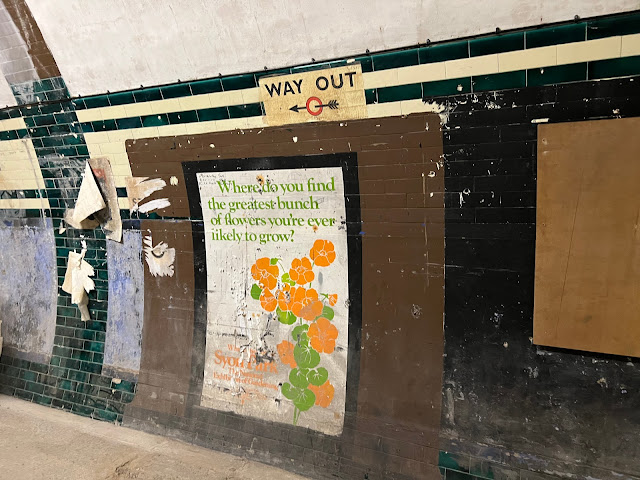Those of you who know me will probably know that I'm fascinated (perhaps even a little obsessed if I'm honest) with the London Underground. I find the history of it fascinating and in particular I love the disused stations. These empty, or at least seemingly empty, places dotted all over the network and all the hidden history they hold is something I'm incredibly interested in. For years I've wanted to go on a tour of one of those that do get opened up to the public and I finally got the chance to join a tour around the former Aldwych tube station over the summer. I'm not going to lie I was super excited about this (having booked it months in advance) and as the day finally approached couldn't stop thinking about the fact I was actually getting to visit one.
 |
| Main entrance to the station with its original name, Strand above the door |
Despite not being used by passengers since the early 1990s anyone wandering up the street where the station is and who is in any way familiar with tube building design can not fail to identify this as an Underground building (even if the obvious signage clues hadn't been there), with its distinctive oxblood red tiling, just one of many designed by the architect Leslie Green. Aldwych tube station was opened in 1907 and was originally called Strand after its location. It was built on the site of the demolished Royal Strand theatre and was the terminus station (the only station in fact) on the very short branch line connecting it to Holborn station. There were plans to extend the line beyond Aldwych but these never came into being. In 1915 it was renamed Aldwych station to avoid confusion with Charing Cross station which at that time was also called Strand!
It wasn't long before passenger numbers fell to a very low amount and it was considered for closure on several occasions. Before this happened one of the station's platforms was permanently closed in 1917 and from the early 1960s the station only operated during peak hours. It was eventually closed in 1994 when the cost of repairing the beautiful Edwardian lifts and bringing them up to modern safety standards proved too expensive to justify when compared to the low passenger numbers passing through the station. Those lifts are now no longer operational so the only way to get down to platform level and back up to street level is via 160 steps (something to keep in mind if you're thinking of joining a tour).
 |
| Looking into one of the two lifts |
 |
| One of the never used lift shafts, later used by The Prodigy in their Firestarter video |
Whilst the station may not have seen huge footfall during its time as an open passenger station it has been used for a range of other things, both when it was in use and since it was closed. It was used during both the First and the Second World Wars, during the First to shelter artworks from London galleries and museums and for the same purpose in the Second World War as well as being used as a bomb shelter. Perhaps not surprisingly the station and platforms have also been used in various TV programmes and movies as well as in The Prodigy's Firestarter video (take a look at the photo of the unused lift shaft above and then watch the music video again). Evidence of its many different guises in these movies etc. can be seen with mocked up posters dotted around the platform and even a fake roundel sign saying Whitechapel. A few of the posters I particularly liked can be seen in photos below. Alongside this the station has also been regularly used since to test various prototypes etc. ahead of them being rolled out across the network, evidence of which can also be seen around the station.


Above and below shows the platform and track that was closed in 1917. The track below is original and is the oldest surviving track on the Underground network.
Above and below photos are of the platform used up until the station closed in 1994. This looks much more like we know Underground stations to look like with the coloured ceiling tiling and the more modern tracks. If you look beyond the painted section in the photo above however you can also see a part that remained undecorated, as a way of cost cutting, because the station only needed to accommodate short trains due to the low passenger numbers.








I'm not going to give away too much more from the tour, you can, of course, find information online but to be honest joining a tour yourself is the best way to find out more about this place. The tour really was excellent and definitely lived up to all the hype I had built up about it in my head beforehand. If you have an interest in the London Underground, London history, modern history, 'abandoned' places etc. this is something you should definitely consider doing. The guides were very knowledgeable and clearly very passionate about their subject. The time down there flew past and I was genuinely disappointed when it finished.
Hidden London offer a number of other tours as well as the Aldwych tour and I would definitely like to go on another if I can at some stage. A word of warning that the tours do seem very popular and only have limited numbers, I was disappointed several times before I managed to secure spots. You can sign up for their e-newsletter which gives you an exclusive booking window when new tour dates are announced and before tickets go on general sale and I would recommend you sign up and take advantage of that if you want to be sure of securing a place.
















Comments
Post a Comment